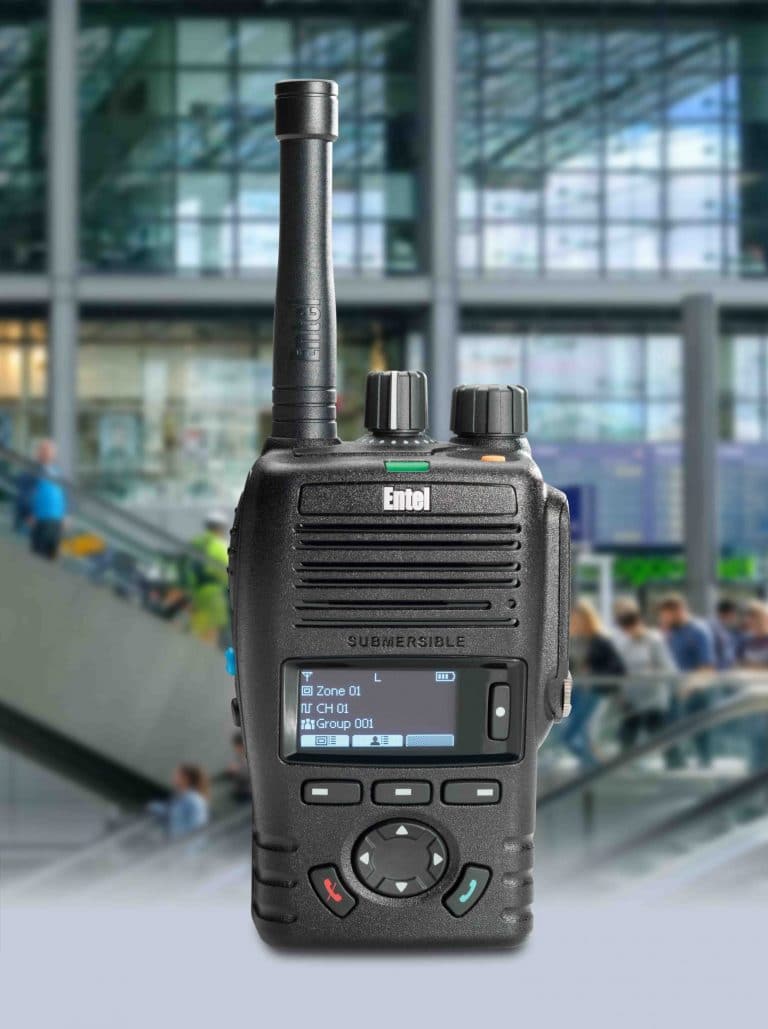Factory Radio Hytera PD405

Factory Radio Walkie Talkie
For industrial operations within a factory, we recommend the Hytera PD405 factory radio, for improving communications efficiency. It is an excellent upgrade for business process improvement.
The factory radio has proved reliable with our industrial customers, and in fact we have never had one returned under warranty, due to failure.
The Hytera PD405 is tough enough to withstand light water splashes, and light product manufacturing dust.
If your factory has a lot of moisture and dust, then there are other options, such as the Entel DX400 series that we can recommend.
For a product demonstration of the Hytera PD405 at your site, why not get in touch.
Benefits of using radios such as the Hytera PD405, are staff safety and improving communications speed.
Key Features of the Hytera PD405
- MIL-STD-810 C/D/E/F/G standards
- IP55 Compliance
- Dual Mode (analogue & digital)
- TDMA Direct Mode in DMO
- 256 channel capacity, 3 zones
- Supports mix (analogue & digital) channel
- One Touch Call/Text message
- Digital voice call function
- Digital text message function (pre-programmable message)
- VOX
Standard Package
- Radio
- Standard Antenna
- Li-ion Battery (1500mAh)
- Single Charger & power supply
- Leather Strap
– Belt Clip
RRP: £200.00 Ex. VAT
Business Factory Radio – Choosing the right equipment for you.
It can be confusing for a member of the public who is tasked with choosing a business safety radio for their business, either as the business owner, or as an employee.
Fortunately we can help you understand the various options, as we recognise that most two-way radio dealers websites seem to be designed by ‘techies’ for techies.
I have taken the liberty of looking at other dealers websites, and trying to imagine that I knew nothing about two-way radio.
I am going to explain what all the jargon means, so that you can make an informed decision.
Business Radios
Business radios describe two-way radios that are used by professional business organisations.
When reading websites you will come across terms such as:
Lets start with Analogue (which would be logical I guess).
Analogue two-way radios are available as Handheld (also known as ‘Hand-Portable’ or Walkie Talkies); Mobile (fitted in vehicles), and Base Stations which are the ones that would be at a fixed location, such as a desk.
Analogue radios are the older technology (compared with Digital, which I will come on to later).
This does not mean that analogue is necessarily a bad choice.
Advantages of Analogue radio equipment is that it is generally cheaper to purchase than the newer digital equipment, which still caries a premium in price (though coming down).
You also tend to get a better built radio when compared with a digital one at the same price, which might be a consideration if you are on a tight budget, and need a certain level of resistance to dust and moisture (known as Ingress Protection).
Digital Radio
Digital two way radio has been around for only a few years, and like in the early days of Video Recorders (For those old enough to remember them), there are two main competing standards that you will come across.
The two factory radio standards are firstly DMR, & secondly dPMR.
dPMR is the standard adopted by manufacturers, Icom & Kenwood.
DMR is the standard adopted by manufacturers, Motorla, Hytera, Tait etc.
DMR seems to be slowly winning, with Kenwood now also offering a DMR radio, as well as their dPMR radio range.
As a business user I would recommend you largely ignore the fact that there are two standards, and focus on what the radio system can do for you.
The two standards only become a consideration, when adding to existing digital radios that you may have. If this is the case, then you will need to stick with dPMR (or vice versa) to match your existing radios. We can help and advise you if needed.
One final thing to mention about the two standards is, though they are defined standards there are slight differences in interpretations of the standard between manufacturers.
This means that although for instance your DMR standard Hytera made radio is the same DMR standard as your motorola, some advanced functions may not work, though basic communications should. Ask us for help and advice if required.
Security Radios
We offer a comprehensive two way radio communications service in Lincoln, Hull & surrounding areas including offering security radios & equipment to local security businesses.
Unlike many companies on the internet, we don’t just sell factory radio walkie talkies. Our Lincoln based business can service, repair & install two way security radios into vehicles. This is backed up with proper City & Guilds radio communications & electronics qualifications & experience. We also have professionally trained installation engineers to standard MPT1362.
Hytera Digital Radios (yesway.co.uk)
Lincoln Two Way Radio Communications sales and hire (yesway.co.uk)

